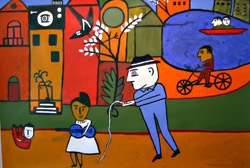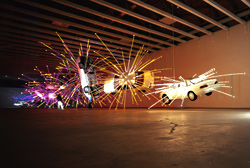Joe Max Emminger
There’s a bright simplicity to the whimsical paintings of extremely local artist Joe Max Emminger, who has been lovingly depicting his hometown for the past 10 years. (“I was born in Seattle on 96th Street in the north end—now I live on 94th,” he says in his artist statement.) In his eye-catching acrylic on paper tableaux, Emminger uses lots of vivid oranges, unadulterated whites, a lovely shade of blue, and bold black lines—and an ongoing narrative involving a man and a woman falling in love, a bounding brown dog, a white pear, music, and boats. Sometimes the moon makes an appearance. Though almost humorous, many of his characters look like they’re being tossed about by the wind, at the mercy of unseen forces. None is the worse for wear, but they seem to be offering a colorful reminder of the discombobulating potential of human interaction and all the uncontrollable forces of life. In Proposal, a bug-eyed fearful man with porkpie hat offers a humble bouquet to an oversized woman who looks ready with a kiss, holding her small white heart out to him. Meanwhile a brown dog topples by in the foreground, while a curious crow perches on the man’s head looking down inquisitively as if to say, “You sure you know what you’re doing, bud?” Or maybe “Get on with it, already!” Winter Garden presents a more muted palette in burnt orange and white and black. Erasures are visible under the white paint. This lack of “correction”—noticeable in some of his other paintings as well—perhaps remains to indicate that all moments are filled with shadows of past acts, past thoughts, and mistakes. There’s a lot going on in I Love Coney Island, which captures all the mayhem and motion of a boardwalk carnival atmosphere. There’s also frequently a local flavor to the work, with titles and subjects like Fremont Ship Canal. In one of his more odd situations, Nocturnal Chefs, three fellows in fezlike toques appear to be going somewhere
significant—in the middle of the night. One brandishes a whisk, another a fork, the third points a finger. It’s easy to see why Emminger’s iconic images have been tapped for other purposes—they have graced Bumbershoot posters twice, in 1986 and 2004, and the festival’s catalog cover in 1992. Emminger also creates his own posters for his shows—a fabulous habit that seems to be more common in Europe, and would be wonderful to see catch on in this town. (Pictured: Emminger’s It’s Our City.)SUE PETERS








